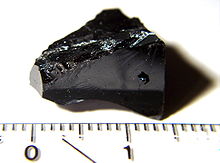II-VI compound semiconductors
As a II-VI compound semiconductor or shortly II-VI semiconductor is called Connection semiconductor consisting of elements of the 2nd main group (alkaline earth metals) and Group 12 elements and elements of the main group 6 (chalcogens) exist. II-VI semiconductors are used in semiconductor technology and, due to a large band gap, are in principle suitable for semiconductor lasers in the shorter-wave spectral range . For green lasers in particular, II-VI semiconductors seem to be very promising so far.
Representative
Typical representatives of the II-VI compound semiconductors are sulfides (e.g. zinc sulfide , cadmium sulfide ), selenides (e.g. zinc selenide , cadmium selenide ) and tellurides (e.g. cadmium telluride , zinc telluride , beryllium telluride ). Almost all compounds form crystals with a zinc blende structure .
In semiconductor technology , ternary compounds such as (Zn, Cd) Se, Zn (S, Se), (Be, Zn) Se or (Be, Cd) Se are also used, which provide greater stability (especially beryllium compounds). exhibit.
Manufacturing
II-VI compound semiconductors are technically produced by epitaxial growth , with III-V compound semiconductors ( heteroepitaxy ) or, more rarely, II-VI semiconductor materials ( homoepitaxy ) being used as the substrate . Above all, GaAs has established itself as the substrate material , with ZnSe and InP also being used. Problems can arise from tension due to different lattice constants of the substrate and semiconductor.
For doping of II-VI semiconductors are suitable elements of the 3rd and 7th main group and Group 15 elements .
properties

Compared to silicon, II-VI compound semiconductors have the advantage that their band gap can be varied with the material composition. In this way, ternary connections can also be combined, in which both the lattice spacing and the energy gap can be varied in a targeted manner. It can be used to specifically change the properties that you z. B. required for applications in optoelectronics . Ternary semiconductors are therefore mainly used for light emitting diodes and laser diodes . The emitted wavelength of the light-emitting diodes can largely be tuned with the composition. This is only limited by the fact that not all compositions can be produced in good quality with every material ratio. This depends on the material and the manufacturing process.
Important material parameters are, on the one hand, the band gap (which, as described, changes with the composition). It determines which wavelength of light (energy of the photons ) can be emitted or absorbed in optical applications. On the other hand, the lattice constant of the material system plays a role. Since the semiconductors can only be produced epitaxially, the materials must be matched to one another. A high grid offset can impair the stability of the grid or lead to tension in the grid. This in turn can lead to severe impairment of the optoelectronic properties.
In the case of ZnO, despite the high potential of the optoelectronic properties, it must first be proven that effective p- doping is possible before broad application can take place.
See also
literature
- Elvira Moeller (Hrsg.): Handbuch Konstruktionswerkstoffe. Choice, properties, application. Hanser, Munich 2008, ISBN 978-344-64017-0-9 .
- Claus F. Klingshirn, Bruno K. Meyer, Andreas Waag, Axel Hoffmann, Jean Geurts: Zinc oxide. From Fundamental Properties Towards Novel Applications (= Springer Series in Materials Science. 120). Springer, Heidelberg et al. 2010, ISBN 978-3-642-10576-0 .
